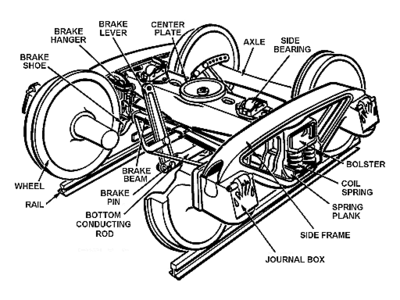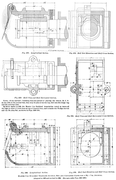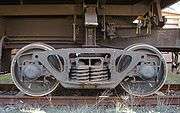List of railroad truck parts

A bogie or railroad truck holds the wheel sets of a rail vehicle.
Axlebox
Also called an axle box, or journal box in North America,[1] an axlebox is the truck or bogie assembly that houses the end of the axle. Early axleboxes contained plain bearings in which the axle spun in a bed of oil. Plain bearings are now illegal in interchange service in the United States; modern axleboxes use roller bearings.[2][3] As early as 1908 they contained a set of long cylindrical rollers allowing the axle to rotate.[4][5] It was also used on steam locomotives such as the Victorian Railways A2 class, the LMS Garratt, the LSWR 415 class, and the GCR Class 1.[4]
Center pin
A large steel pin—or rod—which passes through the center plates on the body bolster and truck bolster.[6] The truck turns about the bolt, and stress is taken by the center plates.[6]
Center plate
One of a pair of plates which fit one into the other and support the car body on the trucks allowing them to turn freely under the car.[6] The one on the truck may also be called center bowl.[7]
Truck side frame
Truck bolster
Each truck has a bolster—a transverse floating beam—between the side frames.[8] It is the central part of every truck on which the underframe of the railcar or railroad car is pivoted through the center pivot pin.[6][8]
Image gallery




See also
References
- ↑ "Railroad Dictionary: J". CSX.com. CSX Corporation. 2012. Archived from the original on 29 July 2014. Retrieved 15 November 2014.
- 1 2 "AAR M-1003 Certified Truck Component Manufacturing". ColumbusCastings.com. Columbus, Ohio: Columbus Castings. Retrieved 19 November 2014.
- 1 2 "General Information" (PDF). SCTCO.com. Standard Car Truck Company. January 2000. Archived from the original (PDF) on 4 March 2016. Retrieved 19 November 2014.
|section=ignored (help) - 1 2 "The Evolution of Railway Axlebox Technology". Evolution. SKF. 7 December 2010. Retrieved 18 September 2014.
- ↑ "Glossary: A". Railway-Technical.com. Railway Technical Web Pages. 2014. Archived from the original on 7 October 2014. Retrieved 19 November 2014.
- 1 2 3 4 "Railroad Dictionary: C". CSX.com. CSX Corporation. 2012. Archived from the original on 1 April 2015. Retrieved 15 November 2014.
- ↑ "APTA PR-CS-RP-003-98 Recommended Practice for Developing a Clearance Diagram for Passenger Equipment" (PDF). APTA.com. American Public Transportation Association. 26 March 1998. Retrieved 17 January 2015.
- 1 2 "Railroad Dictionary: B". CSX.com. CSX Corporation. 2012. Archived from the original on 29 July 2014. Retrieved 15 November 2014.
Further reading
- US Army Field Manual FM 55-20, Figure 8-8, Department of the Army, Washington DC
- Car and Locomotive Cyclopedia 1970
- Forney, Matthias N. (1879). The Railroad Car Builder's Dictionary. Dover Publications.
- White, John H. (1978). The American Railroad Passenger Car. Baltimore, MD: Johns Hopkins University Press. ISBN 0801819652. OCLC 2798188.
- White, John H. Jr. (1993). The American Railroad Freight Car: From the Wood-Car Era to the Coming of Steel. Baltimore: Johns Hopkins University Press. ISBN 0-8018-4404-5. OCLC 26130632.